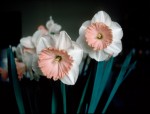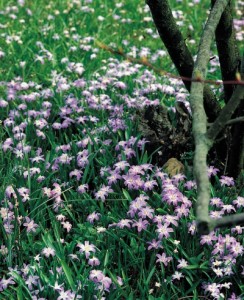The Hoosier Gardener talks about planting spring-blooming bulbs Sept. 16 on Indianapolis’s Fox 59. Here are tips for selecting, planting and maintaining spring-blooming bulbs.
- Tulips, daffodils and crocus are early, mid-season or late bloomers. For a long flowering period, plant bulbs that bloom at different times.
- Buy the largest bulbs you can find. Bulbs should feel firm, not soft or mushy. The greatest selection is usually through mail order or online retailers. Area garden centers and retailers may carry bulbs in packages or in bulk.
- In northern climates, plant bulbs by the end of September, or about four weeks before the ground freezes. In southern locales, plant by early November. Make sure the bulbs you select will thrive in your area’s cold or hot climate.
- If the landscape is heavily shaded, plant early blooming varieties. These will get enough sun for the bulbs to bloom before the trees and shrubs leaf out.
- Plant crocus (Crocus), daffodil (Narcissus), tulip (Tulipa) and Dutch hyacinth (Hyacynthus orientalis) bulbs, pointy end up, 3 to 4 times deeper than the bulb is tall. If the bulb is 2-inches tall, plant it 6 to 8 inches deep. Tiny bulbs, such as grape hyacinth (Muscari), scilla and glory-of-the-snow, about three inches deep.

'Delft Blue' Dutch hyacinth and 'Angelique' tulip make a lovely, fragrant bouquet. Photo courtesy www.bulb.com
Many spring bulbs are fragrant, such as Dutch hyacinth, daffodils and tulips, so plant them where you can enjoy that attribute. The cultivars ‘Angelique,’ ‘Apricot Beauty’ and ‘Keizerskroon’ top the fragrant tulip list. For daffodils, consider ‘Pipit,’ ‘Thalia,’ ‘Geranium’ or ‘Actaea’
- For the best display, plant bulbs in clusters or uneven numbers or in drifts.
- No need to fertilize the bulbs when planting. They have all the energy they need to bloom next spring.
- After planting, water the bulbs well.
- Think of tulips as short-lived perennials. From year one to year two, tulips may have 30 percent fewer flowers. Each year, the number of flowers will likely diminish, so plant a few new ones every fall for that lovely tulip color in spring. By the way, deer see tulips as lollipops. Squirrels like tulip bulbs, too.
The best value and most reliable bloomer, year after year, is the daffodil. The deer and squirrels do not bother them.
- Next spring, the bulbs can be cut for indoor enjoyment. Be sure to leave most of the foliage attached to the bulb until it turns yellow, brown and falls flat, a process called ripening. The foliage processes the nutrients the bulb needs to bloom next spring.
Naturalizing hint:
Minor bulbs, such as scilla (Scilla) and glory-of-the-snow (Chionodoxa) , are ideal for naturalizing in the lawn. These bulbs bloom early enough in the season that their foliage has time to ripen before the lawn needs to be mowed.
Here are more tips from the Hoosier Gardener for planting minor bulbs.



